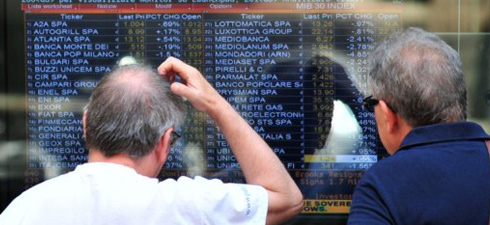The Battle of the Euro has truly begun. Edward Altman, analyst for Classis Capital, forecast a month ago already that: “The final battle for the survival of the euro will be held, not in Spain but on the picturesque beaches and among the cathedrals of Italy”. Many believe that in the long run, a Greek bankruptcy can be absorbed. That is not the case for Italy.
The third largest economy of the eurozone, behind Germany and France, is too big to fail, to borrow a phrase used during the 2008 US crisis. But it is also too big to save.
Greek sovereign debt totals €350 billion. Italy’s is €1.6 trillion. Greece pays, as interest on this debt, the equivalent of 6.7% of its Gross Domestic Product (GDP) and Italy, 4.8%, in other words, more than Portugal. Within the financial community, some, such as Michael Riddell, of M&G Investments, look beyond the battle and forecast a “carnage”.
In reality, the result is not the one imagined. Altman stresses that “the outcome of the battle is not clear”.
If Italy fails, US banks will have to pay out enormous sums
Despite the mountain of debt and the burden of interest on debt, the fundamentals of the Italian economy, beyond the political uncertainties, remain better than those of the other European countries in crisis.
Unlike Greece, public accounts – excluding interest on debt - are balanced. Two thirds of the public debt is in the hands of banks and private Italian citizens, and the country has a wide industrial base that can be revived through exports. Yet, Italy is experiencing sluggish economic growth. If each year, the GDP rises and if, excluding interest, the debt-to-GDP ratio rises rather than falls, then, at the current pace of economic growth, its reduction is but a chimera. Thus Barclays Capital forecasts for 2050 a debt-to-GDP ratio still equal to the current 120% level.
This contrast in Italy’s economic situation explains why it took so long for financial speculation to attack it. For speculators, a collapse of the euro and the extreme volatility that would ensue is a boon. But, simply because the euro is at stake, Europe would commit to defend it and the United States would stand by its side. An analysis of the data by M&G shows that the European banks that invested in Italian bonds insured against payment default by buying CDS (credit default swaps), mostly with US banks.
If Italy fails, US banks will have to pay out enormous sums. But all of this is well-known. So what has changed since early June to persuade US hedge funds to massively intervene on Italian sovereign debt? According to the Financial Times, for about the last month, the hedge funds began selling short on medium- and long-term Treasury bonds (BTP, Buoni del Tesoro poliennali). This strategy is not based on a deterioration of Italian public finances.
In large part, apart from the uncertainties linked to government activity, everything depends on the attitude of Italian banks towards the national public debt. For a long time, explain the Citigroup analysts, they systematically bought the BTPs through financing from the European Central Bank (ECB).
And now?
The difference between the interest paid and that reaped ensured handsome profits. According to some estimates, Italian banks reportedly held BTPs worth up to 150% of their capital and reserves. But in recent months, this strategy reportedly became less lucrative, while, at the same time, the same banks saw their funding problems increase because the cost of fresh money is linked to public debt.
That, Citigroup analysts stress, doesn’t mean that the Italian banks are selling their BTPs. But they are buying less of them, leaving to unenthusiastic foreign investors the task of bridging the gap created when the Treasury bonds are offered. Speculation was launched over the anticipated drop in demand and was combined with an attack in the Stock Market on the banks themselves.
And now? After yesterday’s collapse, the yield of ten-year BTPs jumped from 4.62% to 5.68% in only five weeks. In the world of finance, there is a kind of 7% rule, which states that in the cases of Greece, Ireland and Portugal, when the yield rose beyond 7%, the next step was a bailout, explains Gary Jenkins of Evolution Securities. But the closer yields rise to this threshold, the faster things go.
On average, the three countries stayed above 5.5% for 43 trading days before moving to 6%. They stayed at a level over 6% for 24 days before moving to 6.5% and in 15 days had moved beyond 7%.
Was this article useful? If so we are delighted!
It is freely available because we believe that the right to free and independent information is essential for democracy. But this right is not guaranteed forever, and independence comes at a cost. We need your support in order to continue publishing independent, multilingual news for all Europeans.
Discover our subscription offers and their exclusive benefits and become a member of our community now!












